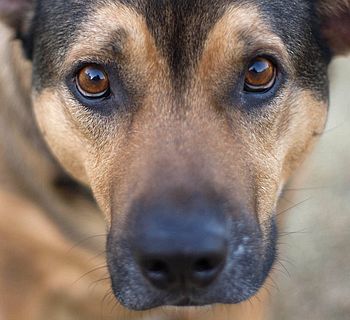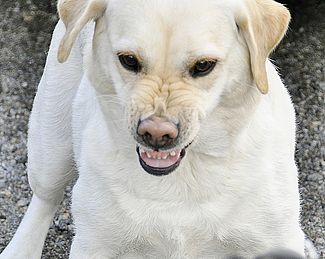What should you do when your dog growls at someone?
I admit, that’s a pretty broad question to answer because dogs growl for a lot of different reasons. There are good growls, like when a dog’s having fun playing tug-of-war and there are bad growls like when a dog growls at a young child. Nobody wants their dog to growl at an innocent child and our first instinct is usually to swiftly correct the dog in order to send a message that we don’t like that behavior. I was guilty of doing that with Haley when she was younger because it’s a common human reaction, but when I stopped to think about why Haley was growling and what she was feeling, I realized that she was only trying to communicate her feelings.
A Dog’s Growl Can Mean:

PHOTO BY ELIZABETH TERSIGNI / CC BY 2.0
The last two reasons, fear and possessiveness, are the ones that usually cause that knee-jerk reaction inside of us to issue a correction. If a dog is fearful or aggressive, you’ll often see other body language signals before you hear a growl. For a lot of dogs, a growl is the last warning sign before they could be provoked to bite or attack, especially if they feel cornered and can’t retreat. It’s a vocal warning, a heads up so to speak, so the last thing you want to do is correct a dog for growling and possibly silence their early warning system. If you know when your dog is fearful or uncomfortable before they resort to a bite, you’ve got the best chance to desensitize them through counterconditioning.
Haley’s Fear of Little Girls
When Haley was young, she had a fear of small children, especially little girls. I think part of her fear came from an encounter we had with some very pushy and aggressive little girls that approached us in the park during her socialization period. Not long after that incident, she would sometimes emit a low, quiet growl when kids would approach her. It’s not a good feeling to have a dog that growls at kids. I wanted Haley to feel comfortable around children and I wanted to be able to take her anywhere without worrying about how she might react to people. Here’s what I did to help her overcome that fear.
My first job was to protect her (and of course, the kids) while we began the counterconditioning process. We first visited parks and watched children play at a distance where Haley was comfortable and relaxed and she got plenty of treats and praise for her cooperation. When we would pass children on our walks, I would create more distance to keep her comfortable and again, she got lots of yummy treats and affection. We slowly decreased the distance to the children and increased the level of interaction but only within Haley’s comfort zone and while ensuring the safety of the kids. It didn’t take long before she started associating good things with the sight and sounds of youngsters and eventually she was even relaxed enough to listen and take commands from them, in exchange for yummy treats of course.
I have to add a disclaimer here. I don’t mean to imply that everything you need to know about fixing an issue with a reactive dog is found in the paragraph above. The concept of counterconditioning is simple to understand in theory, but it’s a slow process that requires you to be able to closely analyze your dog’s behavior and body language. For that reason, it’s best to consult with a professional trainer or canine behaviorist first. I just wanted to give a real example of how Haley’s anxiety issue was treated because she was initially able to communicate her fearfulness to me by growling. Here are some tips if you’re ever in a situation where your dog’s growling at someone.
What To Do When Your Dog Growls at Someone
Growling is the best way your dog has to communicate with you and others that she’s stressed or uncomfortable. It’s her early warning signal before matters could escalate to a bite.
To ensure everyone’s safety, make sure your dog is fully under your control and leashed.
Dogs sometimes react to our own emotions, so it’s important to stay relaxed, move slowly and use a calm tone of voice when your dog is growling or showing signs of stress.
Diffuse your dog’s reaction by putting distance between her and the person she’s reacting to, even if that means turning around and walking in the opposite direction. If your dog is growling at you, slowly move away and give her more space.
Don’t pressure or push your dog to accept or approach the person she’s uncomfortable with. Pressuring a dog that’s already stressed will likely escalate her emotions to a level where she could lash out and bite.
If your dog is growling at you or is being possessive of food or toys, don’t make the assumption that she’s being dominant or defiant. Confronting her or reacting back with an aggressive attitude will likely escalate her reaction and diminish trust.
After analyzing the situation, create a plan to help your dog overcome her issue. Don’t be afraid to ask for help from a professional trainer or canine behaviorist that specializes in using positive reinforcement methods. They can best advice you on the appropriate course of action when dealing with fear or aggression related issues.
What If Your Dog’s Growling at Someone Outside Your Home?
It’s normal for dogs to want to protect their territory and alert you to anything unusual outside by growling or barking at the window. Most people like having a dog that will let them know if something looks suspicious. I don’t mind Haley’s growling when this happens, but the barking can get annoying sometimes. I’ve always used the phrase It’s Okay when I want to calm her down, so instead of saying “No!” or “Quiet!” when she alerts me to something, I say “It’s Okay”. This usually works pretty well and her demeanor changes as if she’s thinking “Okay, you can take care of this one if they come busting through the door”.

PHOTO BY SMERIKAL / CC BY-SA 2.0
Sometimes it’s hard to fight the instinct to correct a dog that’s growling at someone, especially if that someone happens to be us or a small child. But when we understand that our dogs are actually trying to communicate their feelings, we should be thankful they’re giving us a heads up warning and the opportunity to help them overcome the stressful issue they’re dealing with.
Have you ever been concerned when your dog growled at someone? What did you do?



